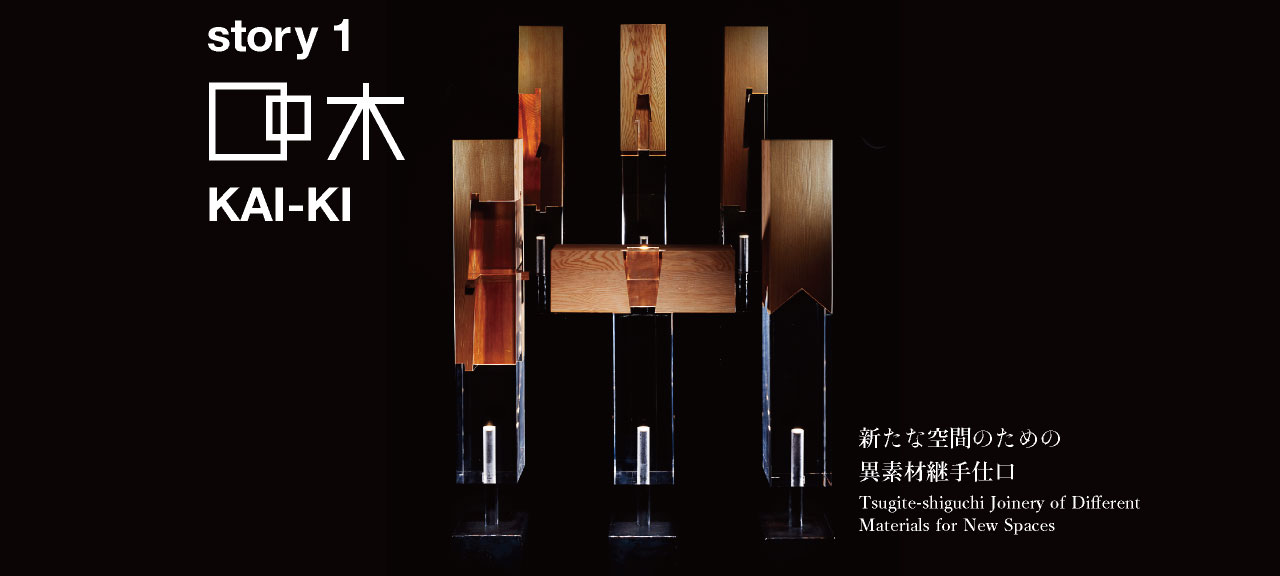
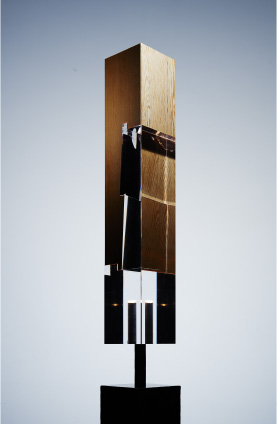
KAI-KI 1 追掛大栓継ぎ

KAI-KI 2 腰掛鎌継ぎ
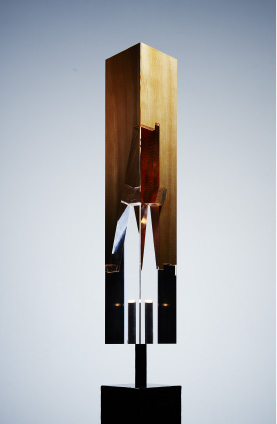
KAI-KI 3 いすかしゃち継ぎ
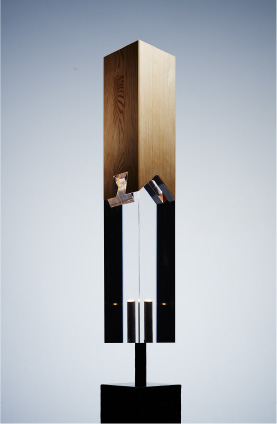
KAI-KI 4 大阪城大手門控柱継手
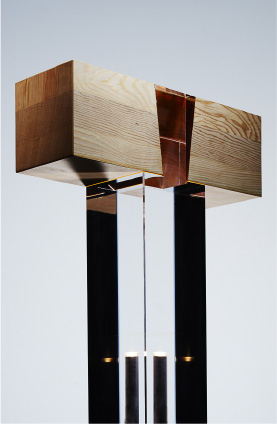
KAI-KI 5 二枚ほぞの住吉案
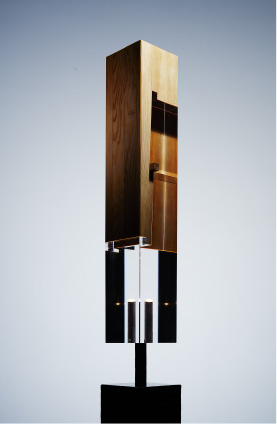
KAI-KI 6 箱栓
継手仕口とは2つ以上の木材を接合する加工技術のこと。材木を伸ばすための組み方を継手といい、材木を交差させる組み方を仕口という。木造建築から木工家具に至るまで最も重要なパーツと言われ、構造的な安定感と意匠的な美しさの両方が求められる。もともとは大陸から伝わってきた技術であるが、精度の高さや種類の多さは日本が独自に発展させてきたといえる。
近年は、生活スタイルの変化により継手仕口の技術もごく限られた使われ方しかしていない。KAIでは、継手仕口の新たな可能性を探るために異素材を組み合わせた仕口づくり「回木」に挑戦した。
Tsugite-shiguchi refers to processing techniques for joining two or more pieces of timber. Methods of assembly for extending timber are called tsugite, while methods intersecting timber are referred to as shiguchi. These are said to be the most important parts in work ranging from timber architecture to wood furniture, and they are required to provide both structural stability and aesthetic design. These techniques were originally introduced from the continent, however, Japan has uniquely developed them in terms of precision and the prolific number of varieties.
In recent years, uses of tsugite-shiguchi joinery techniques have become extremely limited due to changing living styles. KAI has undertaken the challenge of “Kai-Ki” – a method of shiguchi joinery that combines different materials, with the aim of seeking new possibilities for tsugite-shiguchi joinery.

木とアクリルを精度高く組み合わせるため、さいしょに木と木を組み合わせてアクリル版のモデルとなる継手仕口をつくった。アクリル職人はそのモデルに忠実に片側だけの仕口を製作した。じっさいに2つを合わせてみたところ、片方のアクリル仕口と木の仕口の組み合わせがしっくりこない。木工の加工精度に比べてアクリルの加工精度があまくなることが原因だった。そこで、アクリル仕口に対して、あらためてもう片方の木の仕口を新たにつくってみた。今度はピッタリとおさまった。
仕上がった「回木」を見てみると、木と木の組み合わせではオモテに出ることがない仕口面が、光を通すアクリルの材質によってとても美しく映えている。アクリルの軽やかさが、精緻で端正な継手仕口の佇まいに柔らかさを加えたのだ。
半年をかけて6種類の「回木」を仕上げた。追いかけ大栓継ぎ(KAI-KI1)、腰掛かま継ぎ(KAI-KI2)、いすかしゃち継ぎ(KAI-KI3)、大阪城大手門控柱の継手(KAI-KI4)、二枚ほぞの住吉(KAI-KI5)、箱栓(KAI-KI1)。
In order to combine wood and acryl with high precision, first we combined wood and wood and made the tsugite-shiguchi joints as models for the acryl plate. The acryl craftsman manufactured only the shiguchi sides by faithfully following the models. On actually assembling the two pieces, we found that the acryl shiguchi and wood shiguchi parts did not fit together well, the reason being that the accuracy of acryl processing failed to match the accuracy of the woodwork. We thus tried from scratch, making from wood the shiguchi part on the other side of the acryl shiguchi. On doing so, we found that the two parts fitted together perfectly.
On viewing the resulting “Kai-Ki”, whereas the shiguchi faces are normally not visible when combining wood with wood, we found that the translucent acryl material allows light to glow in a very beautiful manner. The lightness of the acryl added softness to the elaborate and clear-cut appearance of the tsugite-shiguchi joints.
We completed six types of “Kai-Ki” over a period of six months. Oikake-daisen-tsugi (KAI-KI I1), Koshikake-kama-tsugi (KAI-KI I2), Isuka-shachi-tsugi (KAI-KI I3), Osakajo-otemon-hikaebashira-tsugite (KAI-KI I4) Nimai-hozono-sumiyoshi (KAI-KI I5), Hakosen (KAI- KI1)

木とアクリルを組み合わせた「回木」は、2018年に六本木ヒルズ・森美術館の「建築の日本展:その遺伝子がもたらすもの」(4/25〜9/17)に展示された。第一展示室「可能性としての木造」のトップをかざり大変注目を集めた。
「インテリアとして部屋にシンボリックに置きたい」「ショップのオブジェとして点在させてみたい」「思い切って茶室の床柱にしてみてはどうか」、さらに「木と鉄、木とガラスなども、組み合わせてみたら面白そう」など。
建築部材としての役割に加えて工芸的な魅力を見出せたことが、継手仕口の可能性と自由度を大いに広げてくれたようだ。将来的には「回木」のような試みが継手仕口の技術の継承にも一躍担えるだろう。
“Kai-Ki” which combines wood and acryl, was included in the “Japan in Architecture: Genealogies of Its Transformation” exhibition staged at the Mori Art Museum in Roppongi Hills in 2018 (April 25 to September 17). It attracted much attention as the main feature in the “Possibilities of Timber Structures” exhibit that was held in the No. 1 Exhibition Room.
“I want to place them symbolically in rooms as interior decorations” “I want to scatter them as objects around my shop” “How about boldly adopting them as alcove posts in a tea ceremony room?” Also, “It would be interesting to try combining wood and iron, wood and glass” Etc.
The ability to combine roles as building members with an artistic appeal seems to have greatly expanded the possibilities and freedom of tsugite-shiguchi joinery. In the future, it is likely that experiments such as “Kai-Ki” will contribute towards passing on the techniques of tsugite-shiguchi.
Speaker: Shiro Miura Interviewer: Kanako Izumi
語り手 : 三浦史郎 書き手 : 和泉佳奈子

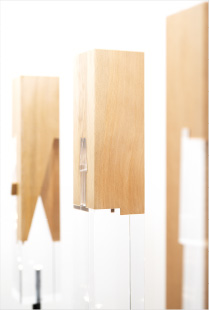
| date | 2019.6.1[sat.]-30[sun.] 11:00-18:00 |
|---|---|
| place | 東山 KAI Higashiyama KAI |
オープン日:6/1〜16、6/21(金)、22(土)、
28(金)、29(土)
オープン日以外は予約制
火曜定休 ※6/10(月)は急遽お休みとなっております。
Open days: June 1~16, 21 (Friday), 22 (Saturday),
28 (Friday), 29 (Saturday)
Reservations are required for other days
Tuesday is a regular holiday
※It is temporarily closed on June 10(Monday)
